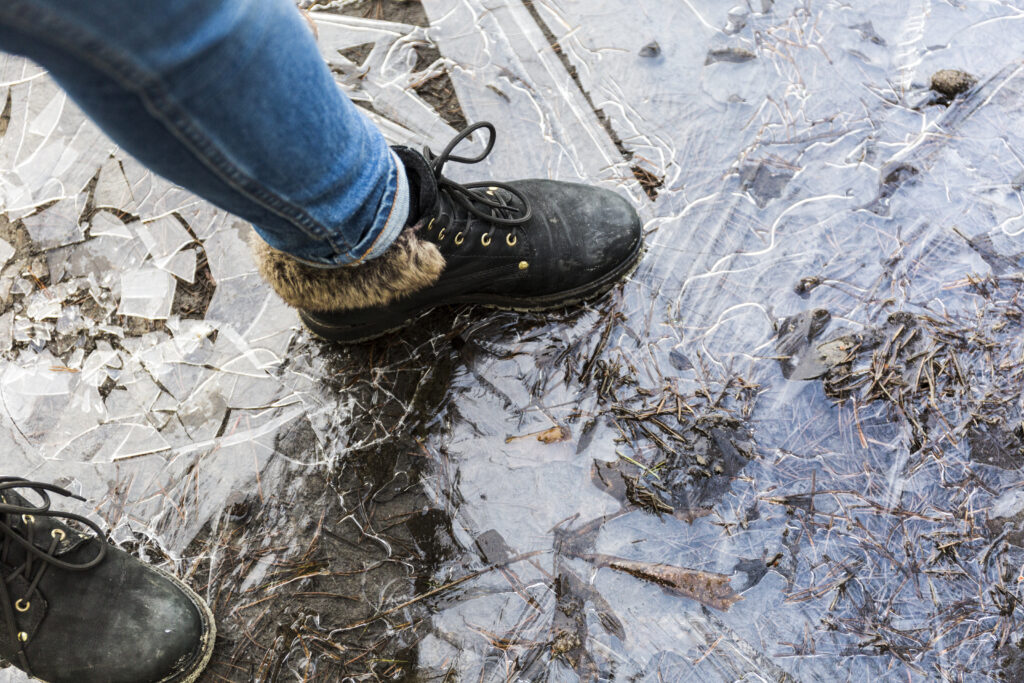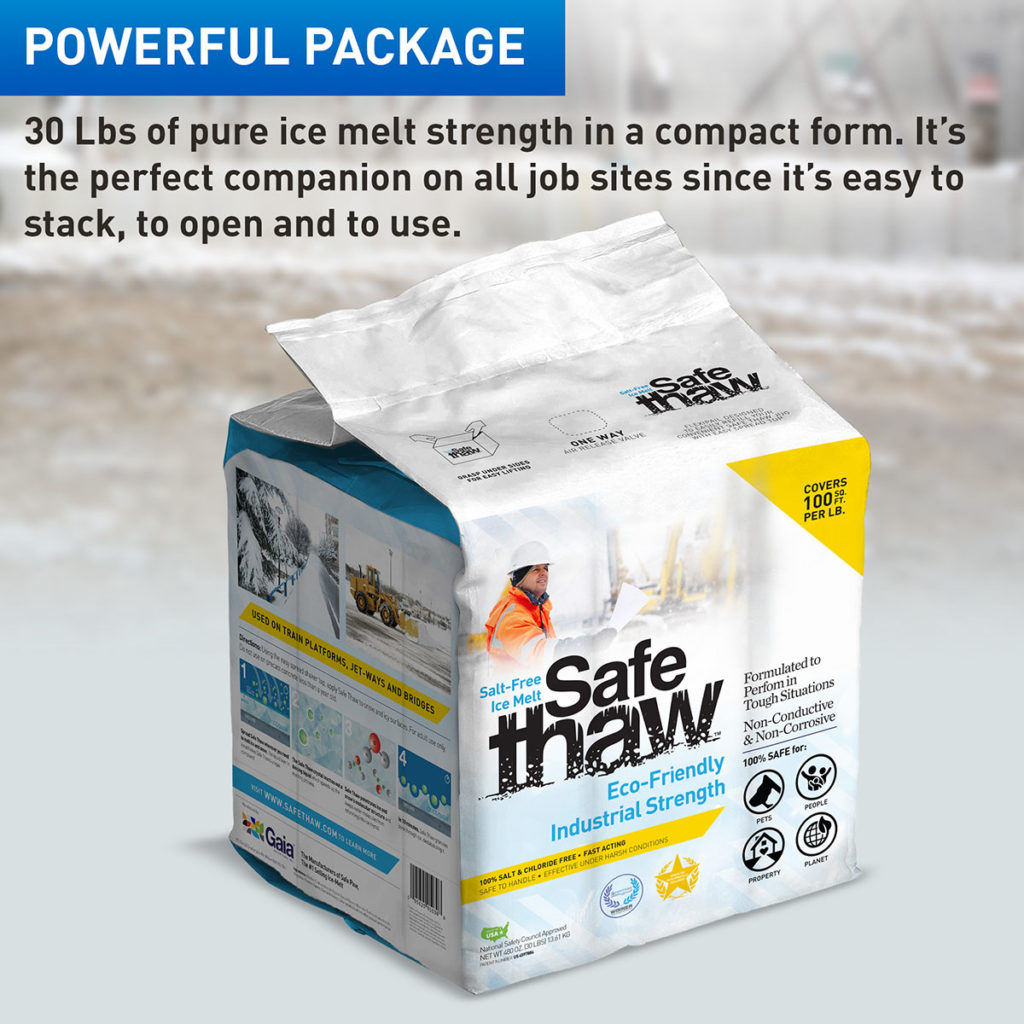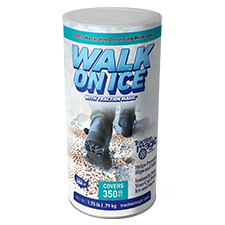Can You Pour Concrete In Winter? Factors To Consider

Cold temperatures can pose unique challenges in construction projects, particularly when it involves concrete. The question on many people’s minds is, “Can you pour concrete in winter?”
The short answer is yes, but with some important factors to consider. Winter conditions can significantly impact the concrete curing process, potentially weakening or damaging structures. Temperature, humidity, and frost are just factors that need careful attention.
In this blog, we will explore the critical considerations for pouring concrete in winter, providing you with some outstanding tricks to maintain your concrete surfaces.

Blizzard Conditions? Stay Safe with Safe Thaw
Safe Thaw was created as the ice management solution for tough winter environments. Ideal in commercial and industrial properties, shops, government agencies, bridges, and construction.
Challenges Of Cold Weather Concrete Pouring
Pouring concrete in cold weather presents a unique set of challenges that can impact the quality and durability of the finished product. Here, we will delve into the key factors that make cold weather concrete pouring complex and explore strategies to overcome them.
- Effect on Curing Process: Cold temperatures slow the curing process of concrete, extending the time it takes to gain strength. This can result in longer project timelines and delays in subsequent construction phases.
- Frost and Freezing: Frost and freezing conditions pose significant risks to freshly poured concrete. When the water in the concrete mixture freezes, it expands and can cause cracks, weakening the structure. Protect the concrete from freezing during the initial curing stages.
- Temperature Fluctuations: Rapid fluctuations in temperature can negatively impact the quality of the concrete. These fluctuations can lead to thermal stress, which can cause cracking and reduced strength. Consistent temperature control is vital to ensure the integrity of the concrete.
- Workability Challenges: Cold weather affects the workability of concrete, making it more difficult to handle, place, and finish. The concrete mix may stiffen quickly, reducing the time for proper placement and finishing techniques.
- Concrete Protection: Once poured, concrete needs protection from cold weather elements to ensure proper curing and strength development. This includes insulation, thermal blankets, and windbreaks to maintain a favorable temperature and prevent frost damage.
Factors To Consider When Pouring Concrete In Cold Weather
Pouring concrete in cold weather presents unique challenges that require careful consideration. Understanding the factors involved is crucial to ensure the success of your construction project. Here, we will explore the key factors to consider when pouring concrete in cold weather conditions.
Temperature Control
Maintaining proper temperature during concrete pouring is essential for optimal curing. Cold temperatures can slow down the hydration process, leading to weaker concrete. Aim for a minimum concrete temperature of 50 °F (10 °C) during placement and initial curing. Use insulating blankets or heating systems to prevent temperature drops during curing.
Concrete Mix Design
Adapting the concrete mix design to cold weather conditions is vital. Increase the cement content to generate more heat during hydration. Implementing admixtures, such as accelerators, can also enhance early strength development. Carefully consider the water-to-cement ratio to ensure workability without compromising strength.
Protection Against Frost
Frost poses a significant risk to concrete in cold weather. Ensure that the ground is adequately thawed before pouring concrete. Use ground heaters or insulation blankets to prevent frost from forming during curing. Monitor weather conditions closely and schedule concrete pouring during milder periods to reduce the risk of frost damage.
Curing And Protection
Proper curing is crucial for the strength and durability of concrete. Protect the freshly poured concrete from freezing in cold weather. Cover the concrete with insulating blankets immediately after pouring and maintain the temperature within the recommended range. Extend the curing period to allow for slower strength gain.
Timing And Planning
Careful timing and planning are essential when pouring concrete in cold weather. Monitor weather forecasts to identify periods of milder temperatures. Avoid pouring concrete when temperatures are expected to drop significantly. Plan the construction schedule accordingly, allowing sufficient time for curing and protection.
Winter Storms Are Here!
Stay Safe with Our 100% Salt And Chloride-Free, Pet Safe Ice Melt.
Mistakes To Avoid When Placing Concrete In Cold Weather
To ensure your concrete placement goes smoothly, you should be aware of the pitfalls to avoid. We will discuss four critical mistakes to avoid when placing concrete in cold weather, helping you achieve durable and high-quality results.
Insufficient Preparations For Cold Weather
Inadequate preparations for cold weather can lead to disastrous consequences for concrete placement. Failing to thaw the ground or provide proper insulation can result in frozen subgrades and delayed curing times. It’s vital to implement measures like ground heating and insulating blankets to maintain suitable temperatures and prevent frost damage.
Poor Timing And Scheduling
Timing is key when pouring concrete in cold weather. One common mistake is not considering the time of day and weather conditions during placement. Cold nights can hinder the curing process while freezing temperatures during concrete finishing can compromise the strength and surface quality. Plan pours during the warmest part of the day and avoids scheduling in extreme weather conditions.
Neglecting Concrete Mix Design
Ignoring the importance of adjusting the concrete mix for cold weather is a grave mistake. Using the wrong proportions or failing to incorporate suitable additives can reduce workability and decrease strength. It’s crucial to work with a concrete professional to develop a mix design that accounts for cold weather conditions and includes appropriate admixtures to enhance performance.
Inadequate Protection And Curing
Failing to protect and cure freshly placed concrete in cold weather adequately can lead to cracking, scaling, and overall poor durability. Neglecting to cover the concrete with insulated blankets or not providing proper curing techniques can result in rapid moisture loss and decreased strength development. Employ curing methods like curing compounds or maintaining a moist environment for an extended period to promote optimal curing and strength gain.
Tricks To Maintain Your Concrete Surfaces After Construction
After completing a construction project involving concrete surfaces, it’s essential to know how to maintain them effectively. Below, we will explore four additional tricks to help you maintain your concrete surfaces and keep them looking their best.
- Regular Cleaning and Sweeping: To maintain your concrete surfaces, make it a habit to clean and sweep them regularly. This simple practice removes dirt, debris, and stains, preventing them from settling into the concrete and causing long-term damage.
- Avoiding De-icing Chemicals: While de-icing chemicals may be convenient for clearing ice and snow, they can harm concrete surfaces. Avoid using salt-containing chemicals, as they can cause corrosion and damage. Opt for alternatives like Safe Thaw, which is safe for concrete and won’t cause any harm.
- Sealing the Concrete: Applying a high-quality concrete sealer is crucial in maintaining the longevity and appearance of your surfaces. A good sealer creates a protective barrier against moisture, stains, and harsh weather conditions, minimizing the chances of cracks and deterioration.
- Removing Stains Promptly: Accidents happen; sometimes, concrete surfaces can get stained. To maintain the aesthetics of your concrete, address stains promptly. Treat spills and stains immediately using appropriate cleaning methods and products to prevent permanent discoloration.
- Regular Inspections and Maintenance: Periodically inspect your concrete surfaces for signs of damage, such as cracks, spalling, or uneven areas. Address any issues promptly by repairing or patching damaged sections. Regular maintenance helps extend the lifespan of your concrete surfaces and keeps them looking their best.
100% Salt & Chloride-Free Ice Melt for Winter Storm Protection.
Conclusion
Regarding the question “Can you pour concrete in winter?” the answer is yes, but with caution. Various factors must be considered before proceeding. Temperature, moisture, and additives ensure successful winter concrete pours.
Cold weather can slow down the curing process and increase the risk of cracking, so proper planning and preparation are essential. Employing insulation techniques, using accelerators or antifreeze admixtures, and monitoring weather conditions closely can improve the chances of a successful winter concrete pour.
Consulting with a professional contractor is highly recommended to ensure the right techniques and materials are utilized, resulting in a durable and long-lasting concrete project even in the cold winter months.
Try Also Our Other Winter Safety Products:
Safe Paw
The Original and #1 Selling Pet and Child Safe Ice Melt for over 20 years. Guaranteed environmentally safe –It won’t harm animals or children, and it won’t damage your property. That’s Safe Paw. Safe Paw can change how winter affects our planet.

Walk On Ice
The handy disposable canister can be taken everywhere, with the same 100% naturally occurring minerals that provide instant traction on ice or snow. Use it on sidewalks, steps, or as an instant traction agent for your car.



